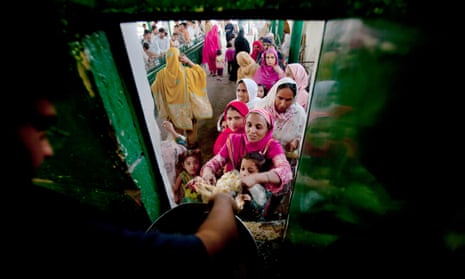There is a growing desire within Pakistan to expand its microfinance sector and innovate. Since the 1990s, however, the country’s attempts to blend commercial and development models (pdf) to tackle poverty, the gender gap and unemployment have struggled against a backdrop of financial and political instability.
From July this year the newly established Pakistan Microfinance Investment Company (PMIC) aims to prove the microfinance sceptics wrong and begin to tackle some of the country’s entrenched social problems.
Set up in partnership with the Pakistan Poverty Alleviation Fund (PPAF), the UK’s Department for International Development (DfID) and the German development bank KFW, it will be the world’s first national level intermediary organisation that will help mobilise funds from investors specifically for microfinance institutions.
According to Yasir Ashfaq, group head of financial services at PPAF, one of its main objectives will be to ensure the organisations it supports channel capital to a variety of sectors in Pakistan’s economy, from crop production, to livestock, enterprises and handicrafts. Ultimately, through the organisation’s investment, microfinance providers will be able to offer loans with lower interest rates to more Pakistanis.
The PMIC was set up after the finance ministry revealed that Pakistan’s microfinance needs will grow significantly by 2018. PPAF’s estimates 20.7 million people want to take out a microloan but only 3.7 million receive them. It is this large supply and demand gap that the investment company aims to fill.
Ashfaq says: “The donors or previously subsidised funds [for microfinancers] are no longer available and the commercial banks are not willing to offer funds to microfinance institutions without guarantees. In order to fill this gap and serve more people additional funding is required.”
DfID, PPAF and KFW will provide the initial 6bn Pakistani rupees (£41m) the PMIC hopes to distribute, with other investors joining at a later stage, says Ashfaq.
However, these changes to Pakistan’s microfinance sector are coming on the back of criticism of the sector. Faraz Khan, co-founder of social enterprise and equity development programme Seed Ventures, believes that the policymakers developing a strategy for microfinance in Pakistan have yet to support the full potential of small businesses.
“These enterprises can’t scale up not only because of the lack of access to finance but also because they are unable to reach specialist training or programmes which can help their businesses to grow or get government support, subsidies or energy rates,” he says.
Brac, an NGO which started working in Pakistan in 2007, views the regulatory environment as supportive to the microfinance sector, but its director for microfinance, Shameran Abed, believes this is mainly for microfinance institutions which want to become regulated banks.
He says: “This is what we’ve seen happen to some of the most established players in the microfinance market. Regulations are less supportive of more informal entities such as NGOs promoting financial inclusion. Most NGOs have now become regulated microfinance banks [to get support].”
Abed believes, however, the latest government regulations for non-banking microfinance institutions are a good start and will allow those that do not want to become microfinance banks to operate under a different legal arrangement.
“This [new investment company] can help to promote financial inclusion if it is willing to provide long-term capital to microfinance institutions, especially ones that show a real commitment to serving the more remote areas. The central bank should also consider setting up a soft loan facility for microfinance institutions that are willing to go into rural areas.”
According to Brac one of the biggest challenges to the sector in Pakistan is expansion into underserved parts of the country like rural Sindh and Baluchistan where branches can not get enough borrowers, experienced staff are hard to come by, and workers from other areas are reluctant to relocate.
However, scaling up to make microloans available to more people will be expensive. Ashfaq says: “The Microfinance Growth Strategy 2020 forecasts that the sector would require additional equity, debt and deposits of up to US$3bn [£2.1bn] to reach up to 10 million borrowers.” The country had 3.1 million active borrowers in 2014.
As well as these stumbling blocks, microfinance initiatives in Pakistan are also subject to the same criticism they have encountered globally. The overhead costs of microfinance remains high and risky, and potentially fruitful projects are often unlikely to be invested in as most projects are selected because investors expect to get 90% of their money back if not more.
It is also uncertain if these initiatives are able to offer an escape from poverty as financed projects often fall short of becoming and remaining profitable in the long run.
Adeel Malik, global fellow in the Economies of Muslim Societies at Oxford University’s Department of International Development highlights that the microfinance sector does not operate in a vacuum, saying it is important to recognise that microfinance operates in a larger political economy context that is defined by profound structural inequalities which are expanding.
“Although feudal structures are weakening, land continues to remain an important economic and political asset in Pakistan,” says Malik, explaining that poverty and illiteracy are most rife in regions with high levels of land inequality.
“Microfinance may restore some individuals from the depths of poverty but it’s unclear if it can offer a permanent avenue of economic and social mobility.”
- This article was amended on 26 February 2016. An earlier version said that Pakistan’s microfinance sector would require additional equity, debt and deposits of up to US$300m [£215m] to reach up to 10 million borrowers. The sector actually would require US$3bn.
Join our community of development professionals and humanitarians. Follow @GuardianGDP on Twitter.

Comments (…)
Sign in or create your Guardian account to join the discussion